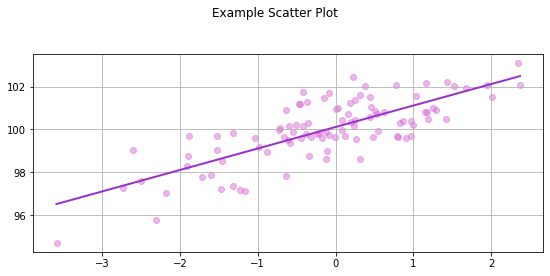Basic Packages - Python and Jupyter Notebook
Econ 570 Big Data Econometrics - 2nd TA session
Jupyter Notebook Basic
The Jupyter Notebook has two modes:
-
command mode: blue cell border
-
edit mode: green cell border
While in command mode (press Esc to activate)
- Enter: take you into edit mode
While in edit mode (press Enter to activate)
- Esc: take you into command mode
Shortcuts in both modes:
-
Shift + Enter: run the current cell, select below
-
Ctrl + Enter: run selected cells
-
Alt + Enter: run the current cell, insert below
-
Ctrl + S: save and checkpoint
While in command mode:
-
A to insert a new cell above the current cell, B to insert a new cell below.
-
M to change the current cell to Markdown, Y to change it back to code
-
D + D (press the key twice) to delete the current cell
** you can check more shortcuts in [ Help -> Keyboard Shortcuts ]
Jupyter Notebook Extensions
Jupyter Notebook extensions are simple add-ons that extend the basic functionality of the notebook environment.
How to install (Run the following in a command prompt)
pip install jupyter_contrib_nbextensions && jupyter contrib nbextension install
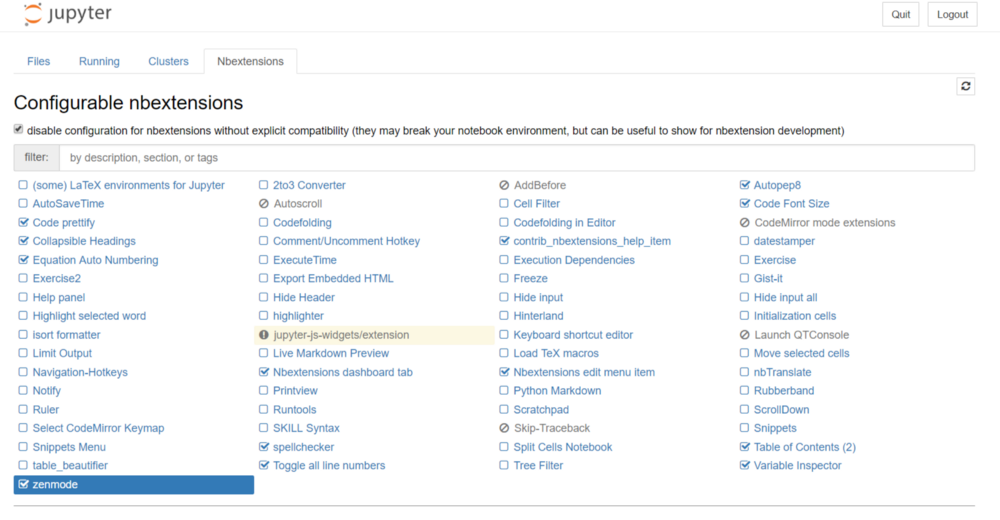
Based on: https://www.geeksforgeeks.org/what-is-the-difference-between-pythons-module-package-and-library/
What is the difference between Python’s Module, Package and Library?
Module: The module is a simple Python file that contains collections of functions and global variables and with having a .py extension file. It is an executable file and to organize all the modules we have the concept called Package in Python.
Example: Save the code in file called demo_module.py
def myModule(name):
print("This is My Module : "+ name)
Import module named demo_module and call myModule function inside it.
import demo_module
demo_module.myModule("Math")
Output:
This is My Module : Math
Package: The package is a simple directory having collections of modules. This directory contains Python modules and also having init.py file by which the interpreter interprets it as a Package. The package is simply a namespace. The package also contains sub-packages inside it.
Example:
Student(Package)
| __init__.py (Constructor)
| details.py (Module)
| marks.py (Module)
| collegeDetails.py (Module)
Library: The library is having a collection of related functionality of codes that allows you to perform many tasks without writing your code. It is a reusable chunk of code that we can use by importing it in our program, we can just use it by importing that library and calling the method of that library with period(.).
Example: Importing pandas library and call read_csv method using alias of pandas i.e. pd.
import pandas as pd
df = pd.read_csv("file_name.csv")
References
Basic packages
NumPy - http://www.numpy.org/
pandas - https://pandas.pydata.org/
statsmodels - https://www.statsmodels.org/stable/index.html#
matplotlib - https://matplotlib.org/
Websites
PyEcon - https://pyecon.org/
Learn Python - https://www.learnpython.org/
NumPy
NumPy - http://www.numpy.org/
The Numerical Python package NumPy provides efficient tools for scientific computing and data analysis:
- np.array(): Multidimensional array capable of doing fast and efficient computations,
- Built-in mathematical functions on arrays without writing loops,
- Built-in linear algebra functions.
# Create 2 new lists height and weight
height = [1.87, 1.87, 1.82, 1.91, 1.90, 1.85]
weight = [81.65, 97.52, 95.25, 92.98, 86.18, 88.45]
# Import the numpy package as np
import numpy as np
# Create 2 numpy arrays from height and weight
np_height = np.array(height)
np_weight = np.array(weight)
# Element-wise calculations
# Calculate bmi
bmi = np_weight / np_height ** 2
# Print the result
print(bmi)
[23.34925219 27.88755755 28.75558507 25.48723993 23.87257618 25.84368152]
# Subsetting
# For a boolean response
bmi > 25
array([False, True, True, True, False, True])
# Print only those observations above 23
bmi[bmi > 25]
array([27.88755755, 28.75558507, 25.48723993, 25.84368152])
# Conditional logic
# np.where(condition, a, b): If condition is True, returns value a, otherwise returns b.
a = np.array([4, 7, 5, -7, 9, 0])
b = np.array([-1, 9, 8, 3, 3, 3])
cond = np.array([True, True, False, True, False, False])
res = np.where(cond, a, b)
res
## array([ 4, 7, 8, -7, 3, 3])
array([ 4, 7, 8, -7, 3, 3])
res = np.where(a <= b, b, a)
res
## array([4, 9, 8, 3, 9, 3])
array([4, 9, 8, 3, 9, 3])
Linear algebra (numpy.linalg)
https://numpy.org/doc/stable/reference/routines.linalg.html
# Linear algebra
import numpy.linalg as nplin
# Return the least-squares solution to a linear matrix equation.
# y = bx + e
x = np.array([0, 1, 2, 3])
y = np.array([-1, 0.2, 0.9, 2.1])
print(x)
print(np.random.rand(1,4))
# A includes constant term
A = np.vstack([x, np.ones(len(x))]).T
A,y
[0 1 2 3]
[[0.45889207 0.93171399 0.69273904 0.44251122]]
(array([[0., 1.],
[1., 1.],
[2., 1.],
[3., 1.]]),
array([-1. , 0.2, 0.9, 2.1]))
b, e = np.linalg.lstsq(A, y, rcond=None)[0]
b, e
(0.9999999999999997, -0.949999999999999)
%matplotlib inline
import matplotlib.pyplot as plt
plt.plot(x, y, 'o', label='Original data', markersize=10)
plt.plot(x, b*x + e, 'r', label='Fitted line')
plt.legend()
plt.show()
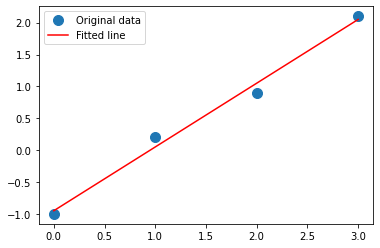
pandas
pandas - https://pandas.pydata.org/
The package pandas is a free software library for Python including the following features:
- Data manipulation and analysis,
- DataFrame objects and Series,
- Export and import data from files and web,
- Handling of missing data. -> Provides high-performance data structures and data analysis tools.
import numpy as np
import pandas as pd
dict = {"country": ["Brazil", "Russia", "India", "China", "South Africa"],
"capital": ["Brasilia", "Moscow", "New Dehli", "Beijing", "Pretoria"],
"area": [8.516, 17.10, 3.286, 9.597, 1.221],
"population": [200.4, 143.5, 1252, 1357, 52.98] }
brics = pd.DataFrame(dict)
print(dict)
print()
print(brics)
{'country': ['Brazil', 'Russia', 'India', 'China', 'South Africa'], 'capital': ['Brasilia', 'Moscow', 'New Dehli', 'Beijing', 'Pretoria'], 'area': [8.516, 17.1, 3.286, 9.597, 1.221], 'population': [200.4, 143.5, 1252, 1357, 52.98]}
country capital area population
0 Brazil Brasilia 8.516 200.40
1 Russia Moscow 17.100 143.50
2 India New Dehli 3.286 1252.00
3 China Beijing 9.597 1357.00
4 South Africa Pretoria 1.221 52.98
# Set the index for brics
brics.index = ["BR", "RU", "IN", "CH", "SA"]
# Print out brics with new index values
print(brics)
country capital area population
BR Brazil Brasilia 8.516 200.40
RU Russia Moscow 17.100 143.50
IN India New Dehli 3.286 1252.00
CH China Beijing 9.597 1357.00
SA South Africa Pretoria 1.221 52.98
# Writing to a csv file.
brics.to_csv("brics.csv")
# Import the brics.csv data: brics
brics = pd.read_csv('brics.csv')
# Print out brics
print(brics)
Unnamed: 0 country capital area population
0 BR Brazil Brasilia 8.516 200.40
1 RU Russia Moscow 17.100 143.50
2 IN India New Dehli 3.286 1252.00
3 CH China Beijing 9.597 1357.00
4 SA South Africa Pretoria 1.221 52.98
brics = pd.read_csv('brics.csv', index_col = 0)
# Print out country column as Pandas Series
print(brics['country'])
print()
# Print out country column as Pandas DataFrame
print(brics[['country']])
print()
# Print out DataFrame with country and capital columns
print(brics[['country', 'capital']])
BR Brazil
RU Russia
IN India
CH China
SA South Africa
Name: country, dtype: object
country
BR Brazil
RU Russia
IN India
CH China
SA South Africa
country capital
BR Brazil Brasilia
RU Russia Moscow
IN India New Dehli
CH China Beijing
SA South Africa Pretoria
# Print out first 3 observations
print(brics[0:3])
print()
# Print out fourth and fifth observation
print(brics[3:5])
country capital area population
BR Brazil Brasilia 8.516 200.4
RU Russia Moscow 17.100 143.5
IN India New Dehli 3.286 1252.0
country capital area population
CH China Beijing 9.597 1357.00
SA South Africa Pretoria 1.221 52.98
# Plotting Time Series
ts = pd.Series(np.random.randn(1000), index=pd.date_range("1/1/2000", periods=1000))
ts = ts.cumsum()
ts.plot()
<AxesSubplot:>
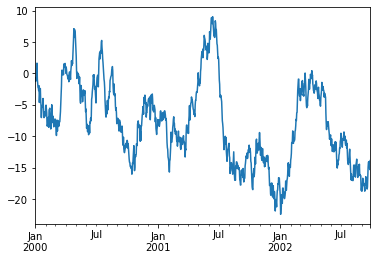
# Plotting DataFrame
df = pd.DataFrame(np.random.randn(1000, 4), index=ts.index, columns=["A", "B", "C", "D"])
df = df.cumsum()
plt.figure()
df.plot()
plt.legend(loc='best')
<matplotlib.legend.Legend at 0x216943bc190>
<Figure size 432x288 with 0 Axes>
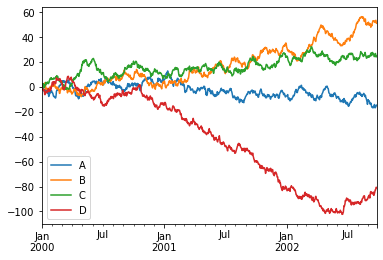
statsmodels
statsmodels - https://www.statsmodels.org/stable/index.html#
- examples: https://www.statsmodels.org/stable/examples/index.html
The package statsmodels is a free software library for python including the following functions:
- Statistical models
- Hypothesis tests
- Data exploration
- Works in Python scripts, the Python and IPython shell and the jupyter notebook
%matplotlib inline
import numpy as np
import pandas as pd
import matplotlib.pyplot as plt
import statsmodels.api as sm
np.random.seed(9876789)
OLS estimation
# Artificial data:
nsample = 100
x = np.linspace(0, 10, 100)
X = np.column_stack((x, x**2))
beta = np.array([1, 0.1, 10])
e = np.random.normal(size=nsample)
# Our model needs an intercept so we add a column of 1s:
X = sm.add_constant(X)
y = np.dot(X, beta) + 100*e
# Fit and summary:
model = sm.OLS(y, X)
results = model.fit()
print(results.summary())
OLS Regression Results
==============================================================================
Dep. Variable: y R-squared: 0.887
Model: OLS Adj. R-squared: 0.884
Method: Least Squares F-statistic: 379.9
Date: Wed, 10 Feb 2021 Prob (F-statistic): 1.30e-46
Time: 17:30:51 Log-Likelihood: -607.03
No. Observations: 100 AIC: 1220.
Df Residuals: 97 BIC: 1228.
Df Model: 2
Covariance Type: nonrobust
==============================================================================
coef std err t P>|t| [0.025 0.975]
------------------------------------------------------------------------------
const 35.2335 31.273 1.127 0.263 -26.834 97.301
x1 -13.9249 14.453 -0.963 0.338 -42.611 14.761
x2 11.0254 1.399 7.883 0.000 8.250 13.801
==============================================================================
Omnibus: 2.042 Durbin-Watson: 2.274
Prob(Omnibus): 0.360 Jarque-Bera (JB): 1.875
Skew: 0.234 Prob(JB): 0.392
Kurtosis: 2.519 Cond. No. 144.
==============================================================================
Notes:
[1] Standard Errors assume that the covariance matrix of the errors is correctly specified.
matplotlib
matplotlib - https://matplotlib.org/
The package matplotlib is a free software library for python including the following functions:
- Image plots, Contour plots, Scatter plots, Polar plots, Line plots, 3D plots,
- Variety of hardcopy formats,
- Works in Python scripts, the Python and IPython shell and the jupyter notebook,
- Interactive environments.
"""
simple demo of a scatter plot.
"""
import numpy as np
import matplotlib.pyplot as plt
N=50
x= np.random.rand(N)
y= np.random.rand(N)
colors= np.random.rand(N)
area = np.pi * (15 * np.random.rand(N))**2
plt.scatter(x,y, s=area, c=colors, alpha=0.5)
plt.show()
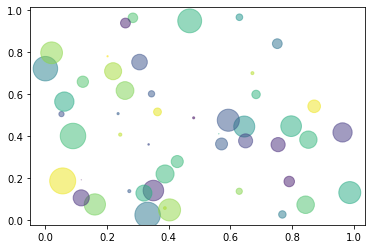
# create figures
fig = plt.figure(figsize=(8, 4))
# adding subplots
ax1 = fig.add_subplot(2, 2, 1)
ax2 = fig.add_subplot(2, 2, 2)
ax3 = fig.add_subplot(2, 2, 3)
ax4 = fig.add_subplot(2, 2, 4)
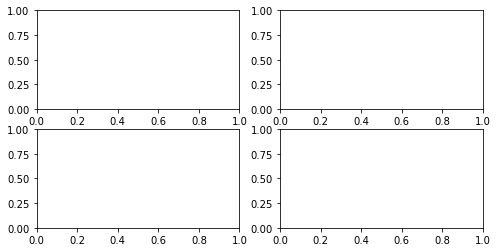
# Filling subplots with content
from numpy.random import randn
ax1.plot([5, 7, 4, 3, 1])
ax2.hist(randn(100), bins=20, color="r")
ax3.scatter(np.arange(30), np.arange(30) * randn(30))
ax4.plot(randn(40), "k--")
fig
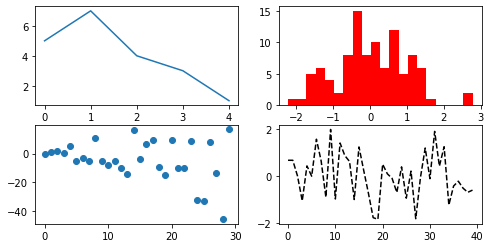
Random number generators
https://docs.python.org/3/library/random.html
import random
def lottery():
# returns 6 numbers between 1 and 40
for i in range(6):
yield random.randint(1, 40)
# returns a 7th number between 1 and 15
yield random.randint(1,15)
for random_number in lottery():
print("And the next number is... %d!" %(random_number))
And the next number is... 2!
And the next number is... 9!
And the next number is... 3!
And the next number is... 22!
And the next number is... 12!
And the next number is... 22!
And the next number is... 4!
Plotting OLS
import numpy as np
import matplotlib.pyplot as plt
import statsmodels.api as sm
# numpy
x = np.random.randn(100)
y = x + np.random.randn(100) + 100
# matplotlib
fig, ax = plt.subplots(figsize=(8, 4))
ax.scatter(x, y, alpha=0.5, color='orchid')
fig.suptitle('Example Scatter Plot')
fig.tight_layout(pad=2);
ax.grid(True)
# statsmodels
x = sm.add_constant(x) # constant intercept term
# Model: y ~ x + c
model = sm.OLS(y, x)
fitted = model.fit()
x_pred = np.linspace(x.min(), x.max(), 50)
x_pred2 = sm.add_constant(x_pred)
y_pred = fitted.predict(x_pred2)
ax.plot(x_pred, y_pred, '-', color='darkorchid', linewidth=2)
[<matplotlib.lines.Line2D at 0x21694596a60>]
